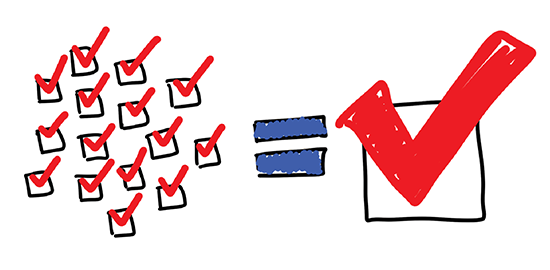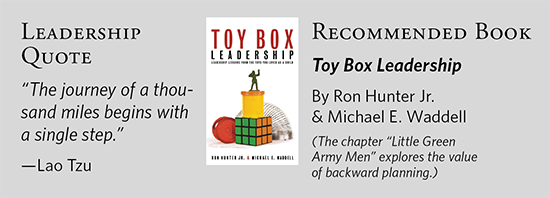
October-
November 2018
Moving Forward
------------------
|






The column "Leadership Whiteboard" provides a short visual leadership coaching moment. It introduces and explains a new sketch in each issue, provides leadership coaching for further development, and shares a leadership quote and recommended book.
Effective Planning Accomplishes Big Goals
A frequent question I hear sounds like this: “How does effective planning work to achieve bigger goals?” Once you set a big goal the real work begins. The reality of working key action steps distinguishes leaders from dreamers. Leaders must begin helping others identify the path to accomplishment and why the accomplishment is needed. After setting a goal, follow these steps.
-
Determine how many small tasks must be done to achieve the big goal. Whether planning a birthday party, a conference, capital campaign, or youth function, all goals are made up of hundreds of smaller tasks. Identify the smaller tasks.
-
Make a list of potential helpers. Divide your helper list into two main categories: task oriented and people oriented. It should be obvious if your helpers are people or task focused. If they never meet a stranger and find a new “best friend” with every acquaintance, obviously they are people oriented. If they prefer to work quietly behind the scenes with limited interaction, chances are, they are task oriented. Getting the right people in the right places saves many headaches down the road.

-
Invite people to handle smaller tasks. Assign tasks with high people interaction to people-
oriented helpers. Assign detail-oriented and technical duties to task-oriented helpers. Divide and conquer. The old maxim many hands make light work illustrates how to spread the responsibility. To create passionate buy-in, show helpers the bigger picture, the end-goal, and what a difference they are making beyond their single task.
The key is creating a backward planning model. Think of the day and moment the goal starts and visualize the successful implementation of all those smaller tasks culminating into the big goal. Ask yourself what needs to be done just hours before that moment? The day before? The week and month before and, yes, even six months before.
-
Create a timeline
of when each task must be done and communicate that task to the one assigned.
Big goals don’t just happen without preparation and plenty of lead time. Last minute planning looks “last minute.” Backward planning turns big goals into smaller, more manageable tasks.
About the Columnist: Ron Hunter Jr., Ph.D., is CEO of Randall House
Publications.

|
|

